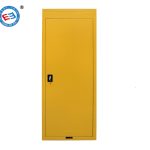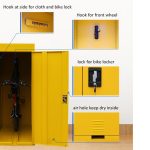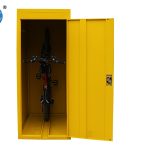Cycling has become an increasingly popular mode of daily transportation for urban residents. Consequently, the demand for steel bike lockers is steadily rising, especially in public areas such as commercial districts, schools, and residential neighborhoods.
For organizations or institutions with large-scale purchasing needs, bulk procurement of steel bike lockers is both an opportunity to enhance facility management and a challenging task. This article provides a comprehensive guide for bulk purchasing, from demand assessment to supplier selection, and logistics transportation to installation and maintenance.
1. Assessing Demand and Budget
The first step in bulk purchasing steel bike lockers is to clearly define the demand. This includes evaluating the quantity, specifications, and usage scenarios.
- Quantity and Specifications: Determine the required number of lockers based on the estimated number of bicycles to be stored. Large commercial areas or campuses may need multiple lockers. Each locker’s capacity and design should meet daily usage requirements. Common designs include single-bike lockers and double-decker lockers. The double-decker design is more space-efficient, suitable for areas with limited space.
- Budget: The price of steel bike lockers varies significantly across brands and specifications, so it’s essential to choose products that fit the budget. For large-scale purchases, negotiate with suppliers for discounts and consider long-term maintenance costs.
- Usage Scenarios: Select the appropriate style based on different usage scenarios. For example, commercial districts may require lockers with higher anti-theft security features, while schools or residential areas may prioritize aesthetic design and ease of management.
2. Selecting Steel Bike Lockers Suppliers
Choosing the right supplier is a critical step in the bulk purchasing process, as it directly impacts product quality, delivery time, and after-sales service.
- Production Capacity and Delivery Cycle: Ensure that the supplier has sufficient production capacity to meet your bulk needs. Understand the supplier’s production cycle and delivery time to ensure products arrive on time.
- Quality Control: Choose suppliers with relevant certifications, and inquire about their quality control processes and product testing mechanisms. Additionally, review customer feedback or case studies to understand their product and service quality.
- Price and After-Sales Service: Prices from different suppliers can vary, but a lower price doesn’t necessarily mean the best choice. Compare the prices, after-sales service, and warranty policies of various suppliers to ensure you receive high-quality products at a reasonable price with long-term support.
3. Pricing and Negotiation Tips
Price is often a key consideration when making bulk purchases. To obtain the most competitive price, you can:
- Understand Wholesale Pricing: Many suppliers offer wholesale pricing or bulk purchase discounts. Familiarize yourself with the discount policies for different quantities and try to negotiate for a better price.
- Negotiation Tips: Prepare your list of requirements, budget range, and quotes from other suppliers in advance to strengthen your negotiation position. Clearly define delivery times, quality assurance, and after-sales support in the negotiation to ensure favorable contract terms.
- Contract Terms: The details in the contract are crucial, especially regarding delivery times, payment methods, and after-sales service. Ensure the contract clearly specifies quality guarantees, delivery schedules, and support.
4. Logistics and Transportation
Logistics and transportation arrangements are essential components of bulk procurement.
- Choose the Right Logistics Method: Ensure the supplier can provide suitable transportation methods and manage risks related to damage or delays during transport.
- Transportation Costs and Handling: Transportation costs usually make up a significant portion of the total cost for bulk goods. Negotiate with the supplier and logistics company on transportation fees, and clarify handling responsibilities.
- Risk Management in Transportation: Goods may be damaged or delayed during transport. Understand the supplier’s transport insurance policies and ensure adequate coverage to minimize potential risks.
5. Installation and Maintenance
After procuring steel bike lockers, installation and ongoing maintenance are equally important.
- Installation Guidance: Suppliers typically provide installation manuals or guidance to ensure lockers are installed safely and securely.
- Maintenance Services: Steel bike lockers are long-term equipment, so regular maintenance and inspections are crucial. Communicate with the supplier to ensure long-term maintenance support, and clarify warranty periods and response times in the contract.
- Scheduled Maintenance: Plan for regular inspections, cleaning, and maintenance of the lockers to ensure they remain in optimal condition and extend their service life.
Bulk procurement of steel bike lockers is not just a simple purchasing activity. It involves multiple steps such as demand assessment, supplier selection, price negotiation, logistics transportation, and post-installation maintenance. By planning and organizing effectively, you can maximize storage space efficiency and ensure the safety and convenience of bicycle storage. Most importantly, establishing a long-term partnership with your supplier will help ensure better service and product quality, ensuring the smooth progress and long-term success of your project.
Dongzhixin Office Furniture provides wholesale and customized services for steel bike lockers. Customization is available based on drawings. For more details, please leave a message or send an email for consultation. We will contact you as soon as possible.




